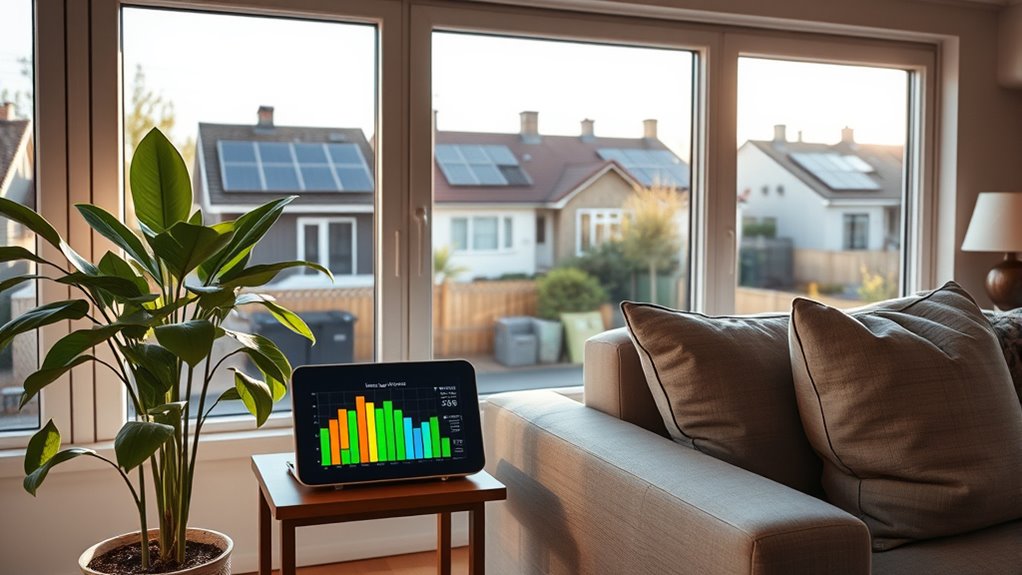To calculate your home’s emissions in five steps, start by evaluating your energy use—check your utility bills and identify how much electricity, gas, or other fuels you consume. Next, learn how your energy provider sources electricity; renewable options are much cleaner. Then, consider implementing conservation practices like turning off unused devices, upgrading to efficient appliances, and installing solar panels. These actions can considerably cut emissions. Keep exploring to discover how these steps and choices make a difference in your overall carbon footprint.
Key Takeaways
- Assess household energy consumption and identify the main sources, especially electricity, to estimate emissions accurately.
- Determine your utility provider’s energy source (coal, natural gas, renewables) to understand your home’s carbon impact.
- Track your energy usage habits, such as appliance use and heating, to identify areas for conservation and reduction.
- Calculate emissions from appliances, heating, and electricity based on their energy consumption and source.
- Implement renewable energy options like solar panels and adopt conservation practices to lower your home’s carbon footprint.

As concerns over climate change grow, many individuals and businesses are starting to feel the pressure of their carbon footprints. You might be wondering how your daily choices impact the environment and what steps you can take to reduce your emissions. One effective way to start is by understanding your home’s carbon footprint and exploring ways to lower it through renewable energy and energy conservation. Knowing where your energy comes from and how you use it can empower you to make smarter decisions that benefit both the planet and your wallet.
First, you should assess how much energy your household consumes and where that energy originates. Electricity is a major contributor to home emissions, especially when it’s generated from fossil fuels. If your utility provider relies heavily on coal or natural gas, your home’s carbon footprint is higher. Switching to renewable energy sources like solar or wind can notably cut your emissions. Installing solar panels on your roof, for example, allows you to generate your own clean energy, reducing reliance on fossil fuels and lowering your overall carbon output. If installing solar isn’t feasible, you can choose a green energy plan from your utility provider that sources electricity from renewables, making a positive impact without the upfront costs of installation.
Alongside adopting renewable energy, practicing energy conservation is vital. Simple actions like switching to LED bulbs, unplugging devices when not in use, and sealing drafts around windows and doors can make a noticeable difference. These small changes reduce your energy demand, which in turn decreases the amount of fossil fuel-based electricity your household consumes. Additionally, adjusting your thermostat by just a degree or two can lead to notable energy savings over time. When you prioritize energy efficiency, you not only lower your carbon footprint but also save money on utility bills. Incorporating natural techniques for sustainable energy such as solar water heating or passive solar design can further enhance your efforts to minimize environmental impact.
You can also take it further by investing in energy-efficient appliances and equipment. Modern refrigerators, washing machines, and HVAC systems use less energy than older models, contributing to a more sustainable household. Combining these upgrades with renewable energy sources creates a powerful synergy that maximizes your efforts to reduce emissions.
Ultimately, understanding your home’s energy use and actively seeking renewable energy options and energy conservation measures puts you in control of your environmental impact. Every step you take—whether it’s installing solar panels, switching to energy-efficient appliances, or simply being mindful of your daily energy habits—adds up. By making conscious choices, you’re not only reducing your carbon footprint but also supporting a more sustainable future for everyone.
Frequently Asked Questions
How Often Should I Recalculate My Home’s Carbon Footprint?
You should recalculate your home’s carbon footprint at least once a year to track your progress and identify areas for improvement. Regular energy audits help you assess appliance efficiency and spot outdated systems that may increase emissions. As your home evolves—like upgrading appliances or improving insulation—recalculating guarantees your efforts are effective and keeps you aware of your environmental impact. Staying proactive helps you make smarter choices for a greener home.
What Are the Cheapest Ways to Reduce Home Emissions?
Imagine slashing your energy bills with simple swaps. You can start by switching to renewable energy sources, like solar panels, which cut costs long-term. Upgrading to energy-efficient appliances makes a noticeable difference, reducing emissions without breaking the bank. These affordable steps create a more sustainable home, helping you lower emissions while saving money. Small changes like these are some of the cheapest ways to make a big environmental impact.
Can Small Changes Significantly Impact My Overall Footprint?
Yes, small changes can make a big difference in your overall footprint. Switching to renewable energy sources, like solar power, reduces reliance on fossil fuels. Upgrading to energy-efficient appliances conserves energy and lowers emissions. Simple actions, like sealing leaks or adjusting your thermostat, also help. These small steps, when combined, profoundly cut your home’s emissions, making a meaningful impact on the environment and your energy bills.
How Accurate Are Online Carbon Footprint Calculators?
You might wonder about the accuracy of online carbon footprint calculators. Their calculator accuracy depends on the data reliability you provide; if you input detailed and honest information, the results become more reliable. However, these tools often use estimates and generalized data, so they aren’t perfectly precise. Use them as a guide to understand your impact, but remember they can’t capture every nuance of your lifestyle.
What Incentives Exist for Reducing Household Carbon Emissions?
Imagine saving money and helping the planet at the same time. You might not realize it, but numerous incentives exist for reducing household carbon emissions. Renewable incentives encourage solar and wind investments, while government rebates make upgrades affordable. These programs motivate you to adopt eco-friendly solutions, lowering your emissions and cutting costs. Don’t miss out—taking advantage of these incentives can transform your home into a greener, more sustainable place.
Conclusion
Now that you’ve learned how to calculate your home’s emissions, you’re ready to make a difference. Remember, every small step adds up—like the tiny gears in a great clock, each action counts. Don’t wait for a knight in shining armor; instead, be the hero of your own story. By reducing your carbon footprint today, you’re shaping a greener future—because even in a world of steam-powered machines, your choices still matter.









